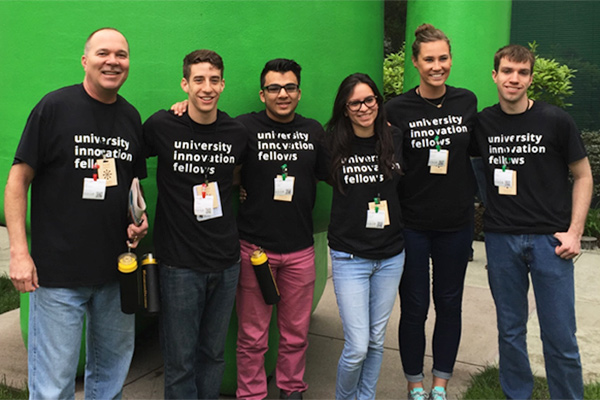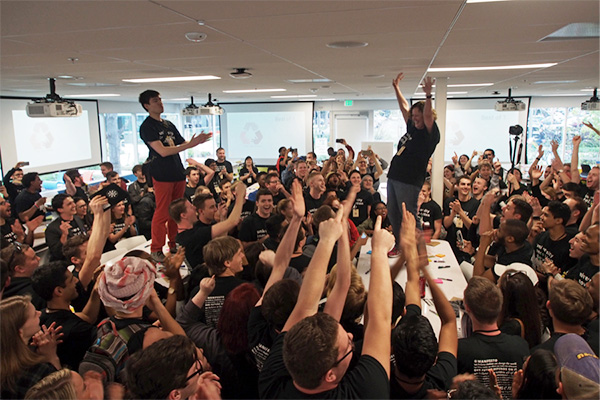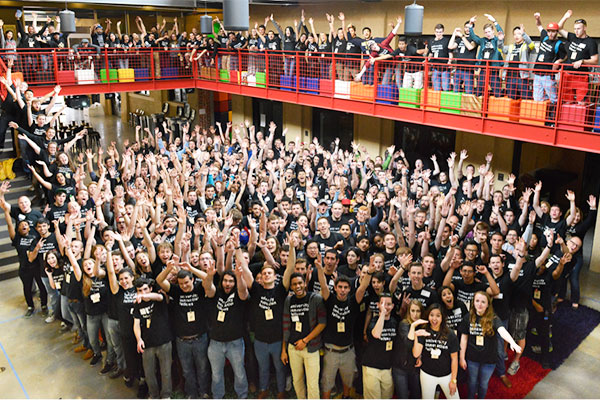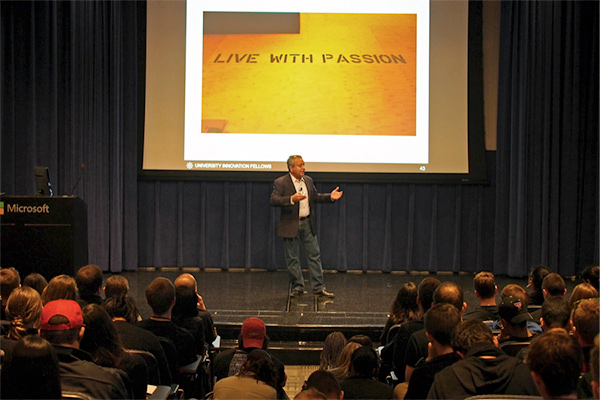Dayton Engineer
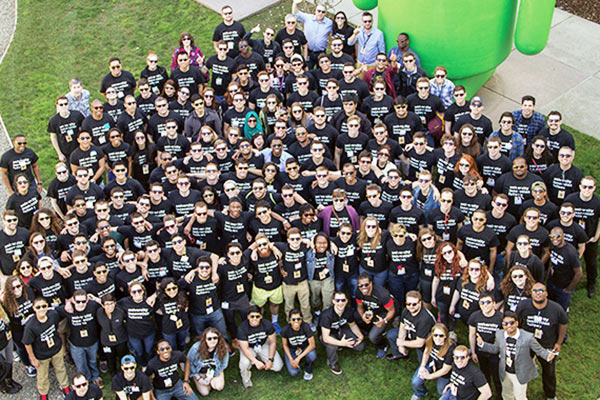
Millennials Meet 10X Moonshots
By Devon Florczak and the University Innovation Fellows
The KEEN's National Center for Engineering Pathways to Innovation named five students from the University of Dayton to the UIF program: Cameron Crasto, Suzy Dorsey, Reid Fuente, Daniela Lopez and Devin Spatz. They are among 155 other students from 47 other schools that the Center has selected to work towards creating more opportunities for students at their schools to develop innovation, entrepreneurship and design thinking skills.
Daniela Lopez states, "The 'Millenials Meet 10X Moonshots' was because Google, one of the main sponsors, encouraged the Fellows to think in an entrepreneurial manner, 10 times how they would normally think. Google encouraged the UIFs to think big and try to 'shoot for the moon' in whatever they pursue," says Daniela. The UD Fellows goal is to start with big ideas at UD and to involve all majors on campus to think entrepreneurially and '10X Moonshots'.
UD’s UIFs summarized their day-to-day experience: All we can say is WOW! Participating as a KEEN Leadership Circle at the University Innovation Fellows (UIF) “Meet Up” in Silicon Valley was the opportunity of a lifetime – being a “Noogler” at Google, strategizing at Stanford, innovating at Microsoft, and much, much more. Of course, you don’t just get to show-up, oh no, we paid our dues in advance!
After being nominated by our respective engineering departments in October, an honor in itself, we had to scramble to make a series of individual videos and gather other information for our formal application. After being accepted, we went through a rigorous six-week discovery process to understand and document the innovation and entrepreneurship (I&E) ecosystem on our campus. Every Friday afternoon we video conferenced with the UIF leadership team to report progress, get feedback and prepare for our next assignment. We then assembled the key I&E stakeholders on campus, briefed them on what we found and, more importantly, on changes we want to implement over the next year. No pressure here!
Finally it was time for the long awaited UIF Meet Up. We hit the ground running when we landed in San Francisco and went directly to a KEEN kick-off presented by Dr. Chris Kitts of Santa Clara University. He did a fantastic job of connecting KEEN objectives to the UIF experience – thanks Chris!
And then we met our 300 new friends at the UIF kick-off at the Crown Plaza Palo Alto. Have you ever seen 300 hungry college students descend on three food trucks? It was a site to behold and a great networking opportunity. We finally met our UIF peers and the excitement was growing exponentially. Here we received our coveted UIF tees with the manifesto printed on the back to wear to Google the following morning.
Day 1: We spent our first full day at Google, and the UIF’ers were psyched up to the max! We spent much of the day going through creative exercises led by Google’s innovation and creativity guru, Dr. Frederik Pferdt, as if we were “Nooglers” (new hires at Google). To kick things off we played a massive game of Rock-Paper-Scissors, Google style.
- Pair off and play a round
- If you lose, your mission is to become an absolute raving fan of the winner
- The winner pairs off with another winner
- The raving fans join forces to support the new winner
- Continue until there’s only a single winner
The energy in the room was off the charts! The moral of the game was that often when working in a team our personal idea may not “win” and sometimes we then mentally check out of the team, when what we should be doing is becoming a raving fan of the idea that does win. This is an important entrepreneurially minded lesson as well as a lesson for life. The rest of the day was packed with more high-energy creativity and innovation skill building activities, including a peek at several Google[x] “moon shot” projects. Here we learned the value of thinking 10X rather than 10%.
Day 2: We spent the 14-hour long second day at Stanford’s Design School, known as the d.school, led by Dr. Leticia Britos Cavagnaro and Humera Fasihuddin. Here we learned about the importance of fluid spaces and that “space is the body language of an organization” – and that the d.school is insanely modular and fluid. We heard words of wisdom from Stanford’s wildly successful entrepreneurs Drs. Steve Blank and Tom Pryor. Steve ranked the two top characteristics of the entrepreneurial mindset as curiosity and resilience, while Tom reminded us that character still matters. And so much more!
Day 3: We started day 3 with a surprise visit to Microsoft. We learned from Jeff Ramos and the team from the Microsoft Garage. They too underscored the importance of 10X thinking, carving out time for projects that can change the world, and empowering people by helping them find their purpose, giving them autonomy and helping them achieve mastery. Back at the d.school we had a surprise visit from Sebastian Thrun, the founder and CEO of Udacity who’s mantra is “there is no failure, only iterative learning." What a day!
Day 4: We had the opportunity to visit some very innovative organizations including Autodesk, Adobe, Co.Lab, Nearpod, StartX and Draper University.
Key Takeaways:
- Space is the body language of an organization, and the setup of the space significantly impacts the outcome of activity in the space.
- Networking and borrowing best innovation practices from others is not cheating; it’s encouraged because we all share the same goal of innovation.
- Use “pretotyping” or “pretendotyping” to test lots of ideas prior to prototyping.
- When prototyping, consider “fake it” vs “make it” to get customer feedback upfront.
- Try to regain the mindset of creative confidence we all had as young children.
- Launch fast and iterate.
- Aim for the minimum viable product when prototyping.
- Think big, think 10X, not 10%.
- Use “yes, and” over “yes, but” most of the time.
- Brainstorm your assumptions about whatever you’re trying to do, and flip them upside down as ideation stimulus.
- Build psychological safety within teams through progressive sharing of basic information (name, birthplace, etc) to more intimate information (my inner critic tells me . . .).
- Learn Edward De Bono’s six thinking hats approach.
- Find what you love to do, and if you haven’t found it, keep looking.
- There is no failure, only iterative learning.
- In a world where you can be anything, be yourself.
- 98% of peoples’ behavior is driven by fear, 2% by aspirations – endeavor to reverse this.
- Do the right thing with no fear.

